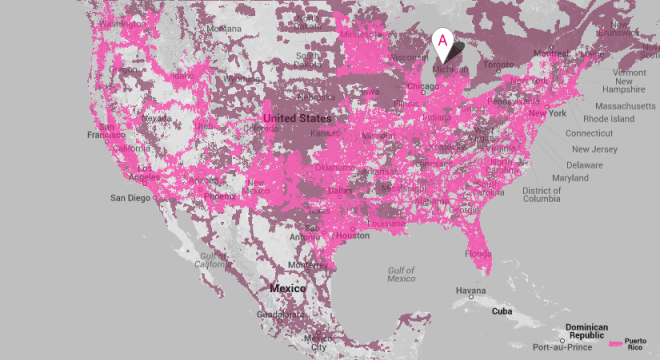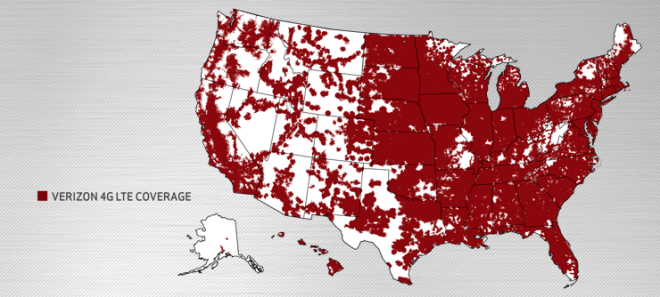T-Mobile’s 2014 resolution? It’s got to be coverage, coverage and more coverage…
With 2013 virtually behind us, it’s impossible for anyone in the tech industry to look at T-Mobile and not be impressed by its moves. Getting rid of the subsidy model that the industry had clung to for so long, then allowing users to upgrade virtually whenever they liked. It wasn’t so much going against the flow as it was changing the flow’s direction entirely as AT&T and Sprint tried to copy Tmo with their own, less-attractive versions of JUMP! The final icing on the cake was free international phone usage in 100 foreign countries.
The move paid off, the Uncarrier phases have kept competitors on their toes and has seen T-Mobile’s subscriber base increase at an incredible rate. Only Verizon added more users in 2013. Not bad for a company whose subscriber base is the 4th largest. Even as we stand on the brink of Uncarrier 4.0, I can’t help but feel that it isn’t enough. You can throw everything plus the kitchen sink in to offers and making the carrier “cool”, but it matters little if the substance behind it isn’t made of strong stuff.
The way I see it, 2013 was a great foundation to build on, setting Tmo up, making it appealing. What needs to happen now is focussed, driven, concentrated effort towards one thing only: Coverage.
If Tmo really wants to compete with the likes of AT&T and Verizon, it has to expand its LTE coverage. Now, we know it’s already in the works. T-Mobile’s 10+10 LTE network has reached almost all the major cities in the States. We heard that in the last conference call. T-Mobile is proud of its quick coverage rollout from 0 to over 205 million people in less than a year. 20+20 is starting to light up in a couple of locations (mainly Dallas, TX), making it even quicker. In those areas that have it, Tmo’s LTE is stupendously fast.
But getting coverage right isn’t just a matter of launching faster networks in lots of locations, it also needs quality. T-Mobile uses mostly higher frequency radio signals for its network. This is great for speed, but not so great when it comes to quality. Range isn’t as good, and it finds it difficult to get through walls and into buildings. It’s why you might notice you have full LTE coverage outdoors, but as soon as you step foot inside your office or home, it drops considerably, or completely. I’ve even heard reports from a few of you that as soon as you even drive just outside the city, LTE vanishes.
Now, there’s a good chance that people who live, work and spend 90% of their time in the LTE-covered metro areas won’t care so much. And the truth is that a large chunk of the U.S. population fits in to that category. But, for the rest of you; those who commute from more rural areas to work in the city, people who visit family out of town, and the millions of others who don’t even get a sniff at magenta-colored 4G LTE, it’s not good enough.
Don’t get me wrong. I realize the reality. If T-Mobile has only relatively recently been able to offer LTE, of course it’s going to focus on the more densely populated areas first. Any company in its right mind would. The reality is also that Verizon now has 95% of American residents covered with 4G LTE (over 500 markets). AT&T has 488 markets covered. T-Mobile: Around 250 markets. We could dip into to the HSPA/HSPA+ areas or the confusion that often surrounds the two different bands operated by Tmo (1700 and 1900). But we shan’t. Everyone in the industry knows that the future of mobile is very much LTE based. HSPA and HSPA+ was – for the most part – a stop-gap, bridging between 3G and 4G (even if some carriers did want to call it 4G).
Like I said, going from zero to 250 markets in the same calendar year is impressive by anyone’s standards. And if it continues at this break-neck pace, it could conceivably catch up with the big two by this time next year. And if it does, that’ll scare the daylights out of its competition, especially if it keeps the Simple Choice plans with unlimited 4G data, international calls, JUMP! and the rest of its great offers.
As I mentioned already, coverage quantity is only half the story. It needs depth, it needs quality. It needs lower frequency airwaves, and Tmo has the cash to buy them.
Verizon has A-block spectrum available for sale, and T-Mobile could buy it. Industry watchers frequently claim Tmo has around $3-$4 billion in reserve especially for buying more spectrum.
In other words, we all know T-Mobile needs to expand fast, and the company itself knows it too.
The big deal here is that Tmo wants to be seen as a genuine threat. It may be a lot cheaper than Verizon. But a Verizon customer will know that he/she will get great, fast coverage almost anywhere there’s civilized life. If they do fancy a change, they could switch to T-Mobile, realize it’s a bit patchy and less reliable, and happily pay a few bucks more to get better service. At least, that would be my mentality. The fact that T-Mobile’s plans no longer tie customers in also makes it easier to leave. All they’d need to do is sell their phone, pay off the EIP and they’re free to switch back.
Offers are great for getting people on to the network. It needs the coverage to make those customers stick.
One thing we may not like to consider for the forthcoming year is a buyout or merger of some kind. Two companies frequently rumored to be in the frame for buying Deutsche Telekom’s controlling share in the company are Dish Network and Softbank (the Japanese company that owns Sprint). DT was happy to accept an offer of around $40 billion a couple of years back for its US network operator. So it clearly doesn’t feel too precious about T-Mobile US, regardless of what we may feel about it. The figure being quoted this time out is around $20 billion.
Personally, I’m not convinced that any sale is going to go through, but if there is one, I’d much rather it was Dish than Sprint.
In the modern market, in the US and the Western world, communications packages are all about bundles. Having home and mobile telecommunications and entertainment lumped together in one deal. Dish Network is very much the “Uncarrier” of the TV world, offering Satellite TV and the Hopper set-top box to free people from their cable companies and enable them to skip advertisements. A marriage between Dish and Tmo could be a match made in heaven. It’d give Tmo the opportunity to expand in to people’s homes.
With Softbank, it’s hard to see the benefits. Sprint hasn’t exactly taken off since the Japanese carrier took over. It would certainly seem much more like a “hey, look what we own” move from Softbank’s perspective, more than a strategic purchase to expand T-Mobile’s reputation.
I’ll be skeptical of any buy-out until anything is announced officially.
All in all, 2014 has an opportunity for T-Mobile to show that 2013 wasn’t just a one-hit wonder. It’s a chance to show it means serious business, and that it’s competing for the long-haul. Another year of sustained growth (both in subscribers and coverage) would see magenta positioned as AT&T’s biggest threat.
What do you want to see from T-Mobile in 2014?
These are all just my thoughts for 2014. There’s little else T-Mobile can do to shake-up the industry. But to compete with the big guns, it needs to match them for coverage in both quality and quantity.


